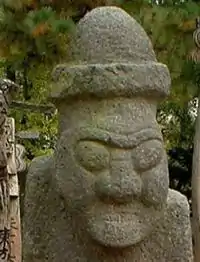| Dol hareubang | |
 A dol hareubang from Jeju Island on display outside the National Folk Museum of Korea in Seoul | |
| Korean name | |
|---|---|
| Hangul | 돌 하르방 |
| Revised Romanization | Dol hareubang |
| McCune–Reischauer | Tol harŭbang |
| Alternate names: Beoksumeori (벅수머리) Museongmok (무성목/武石木) Useongmok (우성목/偶石木) | |
A Dol hareubang (Korean: 돌 하르방, lit. 'stone grandpa'), also called tol harubang, hareubang or harubang, is a type of large rock statue found on Jeju Island off the southern tip of South Korea. They are considered to be gods offering both protection and fertility and were placed outside of gates for protection against demons travelling between realities.
Description
Dol hareubangs are carved from porous basalt (volcanic rock) and can be up to three metres high. The statues' faces feature grinning expressions, bulging eyes without pupils, a long, broad nose, and slight smile, and their hands rest on their bellies, one slightly above the other. In sets of two, one has a higher left hand, and the other a higher right hand. The hat is commonly described as phallic or mushroom-like.
Etymology
The name dol hareubang derives from the Korean word for "stone" (돌; dol), plus the Jeju dialect word hareubang (하르방), meaning "grandfather" or "senior" (할아버지; harabeoji in Standard Korean), and was coined in the mid-20th century. Other earlier names for the statues include beoksumeori, museongmok, and useongmok. Beoksumeori, meaning shaman head, is used in the former area of Jeongui Hyeon (county), museongmok in Daejeong Hyeon and Jeongui Hyeon, and useongmok only in Jeju Hyeon. Historically, the Tamna Chronicles called them ongjungseok (옹중석; 翁仲石), but this usage is unknown today.
History

There are two main theories as to the origin of dol hareubangs: either that they were introduced by visitors from the sea, or that they are a counterpart to the jangseungs (totem poles) of mainland Korea. Jangseungs are also called beoksu in southern Korea, and this similarity with the name beoksumeori lends credence to the second theory.
According to the Tamnaji, a work dealing with the geography of Jeju Island, the first dolhareubang was manufactured in 1754.[1] Dol hareubangs produced from 1763 to 1765 once stood outside the eastern, western, and southern gates of the Jeju City fortress as guardian deities.
Dol hareubangs today

Dol hareubangs have become the symbol of Jeju Island, and replicas of various sizes are sold as tourist souvenirs. The statues are sometimes sold as sources of fertility, and small replicas are sometimes given to women for fertility. The origin of this may have more to do with Jeju Island's present-day status as a "honeymoon island" than tradition.
See also
References
- ↑ Yoo, Myeonng-jong (September 10, 2008). 100 Cultural Symbols of Korea (First ed.). 431, king’s garden office hotel 3rd complex, 72, naesoo-dong, Jongno-gu. seoul, korea: Discovery Media. p. 110.
{{cite book}}: CS1 maint: location (link)
External links
 Media related to Dol hareubangs at Wikimedia Commons
Media related to Dol hareubangs at Wikimedia Commons- Jeju's symbol: Dolhareubang at Jeju Special Self-governing Province website